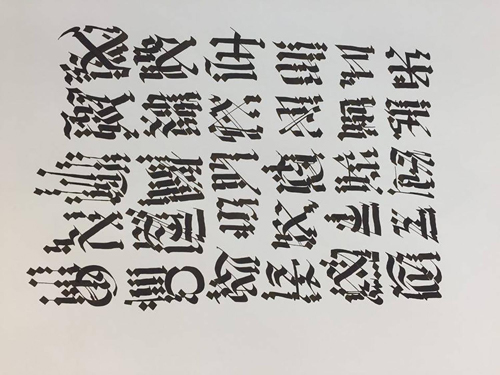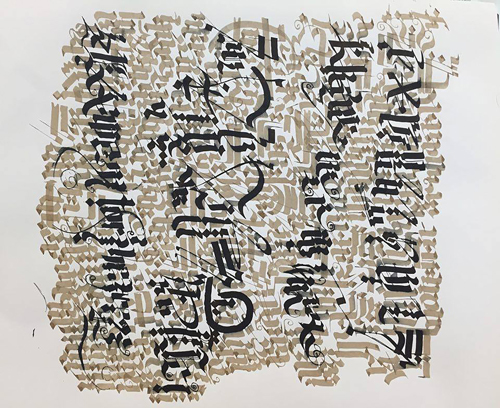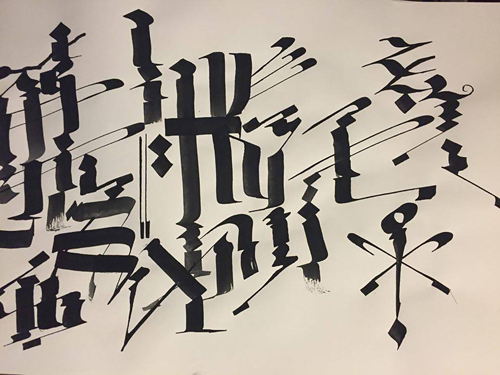Asemic Writing: An Interview with Jay Snodgrass
Diode: As a preface to Signal Decay, your exhibition of Asemic writing, you wrote, “Asemic writing is writing that has the appearance and movement of writing, but avoids or moves away from meaning. Signal Decay speaks to the idea of a possible meaning, or an intended message delivered by some mechanism that is insufficient to transmit the meaning fully. It derives from my feeling of linguistic confusion. I desire to communicate and be understood, but a lifetime of resultant confusion and misunderstanding makes me feel as though the mechanism I am using is insufficient or incapable of bridging the gap between us, the me and the you, the two poles of communication which seem to always be slipping away from one another.”

How did you become interested in asemic writing?
Jay Snodgrass: It’s hard to say. What is an interest? I grew up in Japan on a military base. I had a tremendous exposure to Japanese culture, but I was not required to learn the language to survive. I was surrounded by a language represented symbolically that I was given glimpses into but I never learned to “read” in the conventional sense. Living as a foreigner in Japan I also grew up with a clear sense of not being a member of the greater culture, thus I had early on a sense of exile and, if not entirely exclusion, then a clear mark of separation. I was also protected by the insulating culture of the Military and the larger English speaking, ex-pat culture that exists in Japan, and so I never really had to learn the language. But I always felt a separation. I have the pervading impression of a missed opportunity, a missed chance to connect, to express myself. As I went on I discovered poetry as a means of trying to bridge the gap of communication. Poetry for me is not as much about precision as it is about the exploration of language, and about how to feel my way through the curtains of connection.
In addition to poetry, I’d always doodled in a way in which I’d try to mimic the way I’d seen Japanese people write their own language. I was taken with the way tiny and precise movements could be collected into ideograms, or in terms of Japanese calligraphy, the way the brush strokes of a hand held in an exaggerated and precise way could make marks that seemed correct.
So I was involved in a kind of seeming.
At first I got interested in Vispo and hoped that there was a way I could use the not language I was making into a kind of art. But it seemed to me that Vispo, or what I was seeing as Vispo, was more about manipulating the letters of existing language, or even reusing words as they were in photography and video.
I wouldn’t say there is a singular point when I became “interested” in Asemic. There was a point when I discovered the New Post Literate blog back in 2010 and I submitted a video of what I was doing. A friend was watching me write my drawings and suggested I check it out. I sent a video of my writing in action and they posted it. I felt some validation, but I didn’t think much after that. A few years later I came across the New Post Literate Facebook page and I was astonished to see how big Asemic had become, how global. And I recognized I was part of this larger movement.

Diode: Can you expand on your interest in abandonment, in aesthetic intuition versus legibility, in the mechanisms of communication and how they fail us?
JS: I’ve always been a poor communicator. It’s hard to say what I think and even worse to say what I feel.
I’ve always sort of failed at being clear or at articulating myself the way others can. I’m envious of people who are self-aware enough to know why they feel things and even more at how they can explain why the do. I can’t.
I discovered in poetry that people would be satisfied with what I’ve done and take for having meant something. I can put feeling in to making a poem and let that be how my sentiment or intention crosses the gap between us. If we sit down and you want me to say how I feel, I’ll become very nervous and my internal emotional mechanism will seize. I can’t. But if I can let the coils of language slip off me and the act of writing and using language flow out, then I feel like I’m communicating. It’s like tapping in to something higher, a speaking in tongues.
It is similar with Asemic. The act of writing, the feeling of the movement of writing, creates its own way of meaning, through the action. Often when people ask me what it is, or what it means, I say Asemic is kind of a blend between calligraphy and abstract expressionism. There is a feeling in the act and in the flow if the ink, or paint that goes beyond expression, beyond even the need to communicate.
Sometimes Asemic is alien communication, or the psychic remembrance of a dead language. Variously I have developed different ways of explaining it. All of which fail because language.

Diode: How has Asemic writing informed your poetry/how has poetry informed your Asemic writing?
JS: I recently had a gallery show in Thomasville GA of my Asemic work. I knew that people when they came in would have the same questions: Does it mean anything? What does it mean? The first thing people look for when they see letters is meaning, is words. So, I thought instead of having little cards that explained the process and what Asemic was, I’d write a series of poems and post them next to the art as a sort of pseudo translation, a description that was not a description but which was in fact another artistic act. I also knew that people would go up to them and read them and that this would force another moment or two of engagement from the audience. So, poetry is a kind of translation, a translation of my mind, of the being of the poet. You read the poem and you see into my soup, but you also see into yours, because the reader makes up at least half of the work (arguably).
Ultimately I think my poetry and my Asemic work are similar because they both allow me to express myself without limitation. Asemic really calls into question meaning and how using the medium (language) and the form to render precision but beauty might not be the only way to make poetry.

Diode: How would you define poetry to 5-year-old child using Asemic writing?
JS:

Diode: How would you define Asemic writing to a 5-year-old child using poetry?
JS: Take a line and bend it
around your head until it’s a tunnel
you can fly up into
outerspace.
There the aliens will make
you breakfast
forever.
 
Jay Snodgrass is an artist and poet. His Asemic work has been exhibited in Thomasville, Georgia, and Veracruz, Mexico. His books of poetry include Monster Zero, winner of the Elixir Press poetry award, and The Underflower. He is currently Artist in Residence at Thomasville Center for the Arts. He was Poet in Residence for the FSU Fine Arts Research Center, where he helped make books for Small Craft Advisory Press. He is co-director of Anhinga Press with his wife, Kristine. He teaches at Southern Regional Technical College in Thomasville, Georgia.
|
